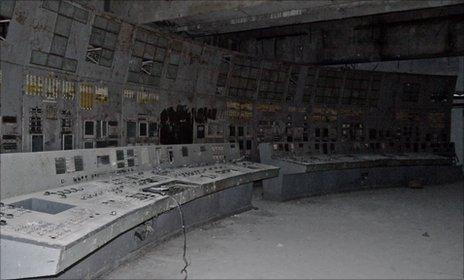Chernobyl nuclear plant shelter faces cash woes
- Published
Former resident of Prypiat Andrey Glukhov returns to the abandoned town
Nearly 25 years after the world's worst nuclear disaster, it has emerged that only half the money needed to safely secure the wreckage of the Chernobyl power plant has been raised.
A new shelter is being built to seal the almost 200 tonnes of melted nuclear fuel rods within the remains of the damaged reactor.
But construction may have to be halted if donor nations fail to provide funds.
The shelter will sit over an existing "sarcophagus" encasing the reactor.
I was shown into the control room of Reactor Four. The room is a mess: dusty and unlit, the semi-circular wall of panels stands silent.
The fact that we're dressed in white protective suits, facemasks and we're carrying radiation counters only adds to the feeling that this place is a memorial to the terrible events of 26 April 1986.
"It's haunting, there's no question about it," said Laurin Dodd, managing director of the Chernobyl Shelter Implementation Plan. "There are ghosts from times past here."
"You can't help but understand when you come to this place how important it is to do things safely. The consequences of not doing so can be beyond our imagination."
In the weeks following the explosion, thousands of people risked their lives building the sarcophagus around Reactor Four. Only ever meant to be temporary, today this ramshackle arrangement of concrete walls and corrugated iron panels is held together with scaffolding.
"This particular scaffolding structure is to help hold up the west wall," Mr Dodd explained.
"After the accident, the west reactor wall was cracked all the way across. It is actually tilted outwards and there was concern that it could collapse and expose the almost 200 tonnes of radioactive fuel that's still inside the shelter to the atmosphere."
New shelter
The area beneath the west wall is now a construction site. Resembling a giant arch and billed as large enough to contain St Paul's Cathedral, the new shelter is being built some distance from the reactor so it can be slid over the top of the existing sarcophagus.
Simon Evans from the European Bank for Reconstruction and Development (EBRD) is overseeing the project:
"Radiation levels as you get closer to the sarcophagus get higher and higher, so the difficulties of building something nearer, multiply. So, if you can build it as far away as possible it makes it easier."

The control room in Chernobyl's Reactor Four is dusty and unlit
The total cost of this ambitious scheme is 1.6 billion euros (£1.37bn; $2.21bn) but despite promises from G8 conferences, the bank is still 740 million euros short. It's also notable that the largest contributor is Europe; Russia - where the reactor was designed and built in Soviet times - is the tenth.
President of the EBRD Thomas Mirow admitted it was a difficult time to raise funds but told the BBC that countries should think beyond the current economic climate.
"This is such an exceptional case," he said. "I think with all the major players in the international community being involved, it should be possible to get the money."
The bank will use the 25th anniversary of the disaster in April to make a final push to raise the necessary funds to build the new structure. But even with the reactor itself secured, the land surrounding Chernobyl will remain contaminated for tens of thousands of years.
- Published2 February 2011
- Published21 September 2010
- Published20 August 2010
- Published6 March 2012
- Published30 July 2010